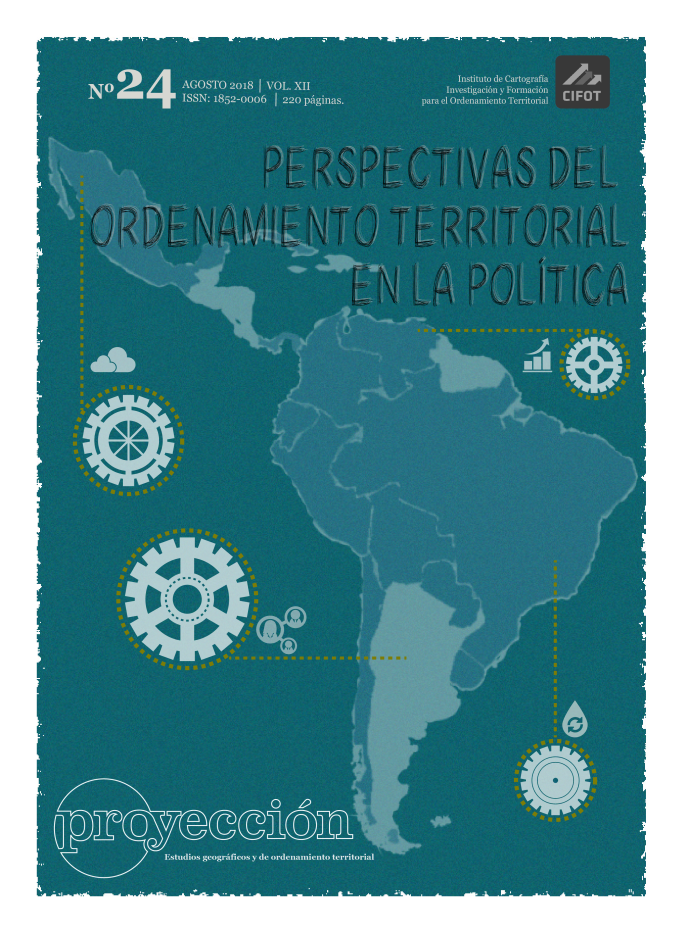Gestión Integrada de Recursos hídricos y seguridad hídrica en la gestión comunitaria del agua: el caso de los Comités Autónomos de Agua Potable en la Cuenca del Alto Lerma
Palabras clave:
Gestión local, Comité de agua, Comunidades, Seguridad hídricaResumen
La Cuenca Lerma ha sufrido infinidad de intervenciones humanas, desde el trasvase a mediados del siglo XX hasta la urbanización e industrialización. Los municipios que forman parte del Curso Alto en esta Cuenca, se han organizado de distintas formas para poder tener acceso al agua. El proceso de descentralización se ha visto cuestionado de manera local, ya que no se ha conseguido los resultados esperados, y las organizaciones gestoras del agua: comités municipales, comités autónomos, organizaciones de vecinos se encuentran en un proceso de adaptación para no desaparecer. Las distintas prácticas realizadas por las organizaciones gestoras y por los habitantes beneficiarios corresponden o no con los modelos nacionales previstos. Por lo que, el objetivo de esta ponencia es, por un lado identificar a los actores y las relaciones existentes en la gestión del agua de tres municipios integrantes del curso Alto de la Cuenca del Alto Lerma, y posteriormente analizar a partir de la Gestión Integrada de Recursos Hídricos (GIRH) y la Seguridad Hídrica (SH), las posibilidades y los retos que se encuentran en esta región.
La metodología consiste en la revisión documental sobre la política hídrica de México, la aplicación de entrevistas semiestructuradas a los gestores del agua en cada municipio y la aplicación de un cuestionario a los pobladores. Concluyendo que: existe una diversidad amplia de gestión local y comunitaria del agua en la microrregión seleccionada, esta variabilidad tiene que ver con fenómenos urbanos como el crecimiento demográfico, la construcción desordenada de la vivienda y la política hídrica; cada municipio si bien tiene límites físicos, sus relaciones hacen una sobreposición territorial compleja, que evoca áreas de influencia diferenciadas, por lo que es necesario pensar en formas de planificación territorial y de gestión de los servicios que superen las limitaciones tradicionales y apoyen la política hídrica nacional. En este sentido, la GIRH y la SH, conceptualmente, se encuentran limitados por las condiciones contextuales que tienen las localidades, las adaptaciones locales de la política y las capacidades de los actores; pero de manera simultánea se pueden encontrar elementos de estos que son aplicables y observables en las organizaciones gestoras del agua, como lo es el caso de los comités de agua potable y su gestión comunitaria.
Citas
AYUNTAMIENTO DEL MUNICIPIO DE XALATLACO (2009). Plan de Desarrollo Municipal de Xalatlaco 2009-2012. H. Ayuntamiento de Xalatlaco, p. 56.
COOK, C., & BAKKER, K. (2012). Water security"¯: Debating an emerging paradigm. Global Environmental Change, Vol. 22, Issue 1, Pag. 94–102. https://doi.org/10.1016/j.gloenvcha.2011.10.011
COSER, L. (1970), Nuevos aportes a la teoría del conflicto social. Buenos Aires, Argentina: Amorrortu.
GALINDO-ESCAMILLA, E. (2007). Pequeños sistemas de agua potable: entre la autogestión y el manejo municipal en el Estado de Hidalgo, México, en Agricultura, Sociedad y Desarrollo, julio-diciembre, México.
GASGA, J. (2014). Gobernanza y gestión comunitaria de recursos naturales en la Sierra Norte de Oaxaca Introducción. Región Y Sociedad, (55).
GÓMEZ Y PALERM, J. (2014). De pipas y piperos: el abastecimiento de agua potable en las zonas periurbanas de valle de Texcoco. Tercer Congreso Red de Investigadores Sociales Sobre Agua, 9 al 11 de abril.
GREY, D., & SADOFF, C. W. (2007). Sink or Swim"¯? Water security for growth and development, Water Policy Vol 9, Issue 6, pag. 545–571. https://doi.org/10.2166/wp.2007.021
MARTÍNEZ-AUSTRIA, P. F. (2013). Los retos de la seguridad hídrica, IV, 165–180.
OSTROM, E. (2007). El gobierno de los bienes comunes. La evolución de las instituciones de acción colectiva. CRIM-UNAM y Fondo de Cultura Económica, México.
PARÉ, L. (2012). Al filo del agua: cogestión de la subcuenca del río Pixquiac, Veracruz.
SADOFF, C. W. (2009). La Gestión del Agua , la Seguridad Hídrica y la Adaptación al Cambio Climático"¯: Efectos Anticipados y Respuestas Esenciales.
INEGI (2016). [En Línea], disponible en: http://www.inegi.gob.mx/ [Acceso el 02 de enero de 2016]
Página oficial del municipio Santiago Tianguistenco (2015): [En Línea], disponible en: http://www.tianguistenco.gob.mx/ [Acceso el 12 de junio de 2015]
Página oficial del municipio Almoloya del Río: [En Línea], disponible en: http://www.almoloyadelrio.gob.mx/ [Acceso el 02 de julio de 2015]
Página oficial del municipio Xalatlaco: [En Línea], disponible en: http://www.xalatlaco.gob.mx/ [Acceso el 12 de enero de 2016]
Descargas
Publicado
Cómo citar
Número
Sección
Licencia

Esta obra está bajo una licencia internacional Creative Commons Reconocimiento-NoComercial-CompartirIgual 3.0.
La revista Proyección establece las siguientes condiciones de publicación para los/as autores/as:
- Los/as autores/as conservan los derechos de autor y ceden a la revista el derecho de publicación bajo la Licencia Creative Commons Atribución-No Comercial-CompartirIgual 3.0 No portada (CC BY-NC-SA 3.0) que permite a terceros copiar, distribuir, exhibir y ejecutar la obra citando siempre la fuente y los datos de autoría según la norma prevista por la Revista Proyección. Esta licencia no permite el uso de la obra con fines comerciales.
- Todos los trabajos publicados por Proyección, Estudios Geográficos y de Ordenamiento Territorial serán bajo la modalidad de gratuidad para autores/as y lectores/as.




























